Corrosion of Silver-Plated Copper Conductors - NEPP
Corrosion of Silver-Plated Copper Conductors - NEPP
Corrosion of Silver-Plated Copper Conductors - NEPP
Create successful ePaper yourself
Turn your PDF publications into a flip-book with our unique Google optimized e-Paper software.
308<br />
Introduction <strong>Silver</strong>-plated conductors are generally specified when wires and cables must have a good<br />
resistance to high temperature. They are invariably insulated with fluorocarbon plastics or<br />
aromatic polymide resin, which have high working temperatures and low out-gassing<br />
properties under vacuum. These wire and cable materials are those most commonly<br />
selected for use in ESA's satellite and manned spacecraft projects. <strong>Silver</strong>-plated copper<br />
wire is also used extensively for military and aerospace applications in both Europe and the<br />
United States.<br />
The purpose <strong>of</strong> this paper is to detail the findings <strong>of</strong> the metallurgical examinations<br />
performed by ESA on cables discovered to have degraded by red plague corrosion. In<br />
addition, an extensive laboratory test programme was undertaken in an attempt to gain a<br />
more comprehensive understanding <strong>of</strong> the red plague phenomenon. The aims <strong>of</strong> this<br />
programme will be discussed, as will the results achieved to date. A test method based on<br />
the laboratory procedures <strong>of</strong> Anthony & Brown 1 has been developed into a draft ESA<br />
specification, which is thought suitable for the acceptance-testing <strong>of</strong> fabricated wires and<br />
cables.<br />
Papers published in the literature 1-6 on red plague are limited to the 1965 – 70 period and<br />
no more recent articles have appeared. This paper will initially reiterate the current<br />
theories related to the mechanism <strong>of</strong> red-plague corrosion and, as a historical record, will<br />
include an account <strong>of</strong> the reasons for the selection <strong>of</strong> silver plated conductors for ESA<br />
projects.<br />
Previous studies <strong>of</strong> redplague<br />
corrosion Two potential corrosion problems were recognised to be associated with the use <strong>of</strong><br />
silver-plated copper conductors in the 1960s. Because <strong>of</strong> their characteristic corrosion<br />
products, they are referred to throughout the electronics industry as 'red-plague' and<br />
'green plague'. Red plague is the cuprous-oxide (possibly with some black cupric oxide)<br />
corrosion product that forms when a galvanic cell is formed between copper and silver.<br />
Green plague is the reaction product <strong>of</strong> some resin-based solder fluxes with copper<br />
oxide; it has been found on tin- and silver-plated conductors and is considered to be an<br />
undesirable cosmetic defect.<br />
A number <strong>of</strong> reports 1-6 were written in the late sixties which established that red plague<br />
originates at breaks in the silver plating <strong>of</strong> copper-wire strands in the presence <strong>of</strong><br />
moisture and oxygen. Although some authors considered the problem to be persistent,<br />
uncontrolled and unsolved, others presented solutions thought likely to avoid the<br />
problem. A NEMA investigation reported 6 that out <strong>of</strong> a total US production <strong>of</strong> 18 to 20 x<br />
10 9 ft <strong>of</strong> silver-plated copper wire, only 10 5 ft (i.e. 0.003%) had a significant amount <strong>of</strong><br />
red plague and that no malfunctions could be attributed to this phenomenon.<br />
Several investigative activities were undertaken by ESA in the mid-seventies. These<br />
included laboratory evaluations, a European red-plague survey, and eventually the<br />
auditing <strong>of</strong> wire manufacturers' premises. It was concluded that silver-plated copper<br />
conductors would be suitable for general spacecraft usage, but essential that the platings<br />
be defect-free and <strong>of</strong> uniform thickness (at least 2μm, and preferably 4μm). It was<br />
considered that red plague could be avoided if the wire manufacturer and the user<br />
companies implemented certain mandatory controls. Also, extreme gauge sizes <strong>of</strong><br />
stranded copper, such as large gauge AWG '0' and ‘4’, should be nickel-plated copper,<br />
and very thin gauge AWG '26' and smaller must use high-strength copper alloy strands<br />
with a silver-plated finish. ESA and its contractors have experienced no practical<br />
problems during wire interconnection (e.g. soldering, crimping and wire wrapping),<br />
hardware integration or service operation with silver-plated wire cables and harnesses.<br />
The results <strong>of</strong> studies 1-5 performed in the 1960s can be summarised as follows:<br />
(i) Imperfections ranging from porosity to deep scrapes penetrate the silver<br />
plating and reveal the copper core <strong>of</strong> a wire strand. Such damage may result<br />
from the use <strong>of</strong> defective wire-drawing dies, wear action between strands<br />
during stranding and braiding operations or when conductor strands are<br />
wound and re-wound from reels to bobbins.<br />
ESA Journal 1984, Vol. 8



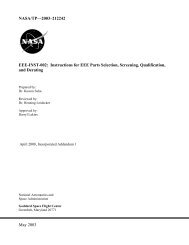


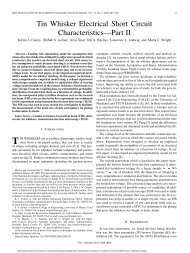
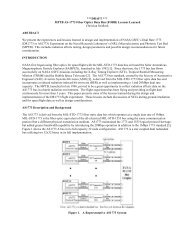

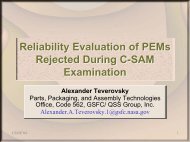
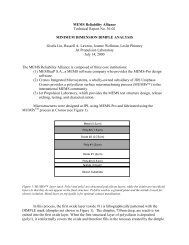
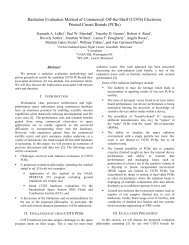
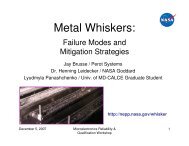

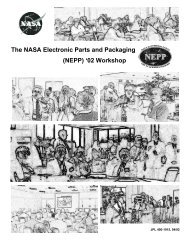

![mil-std-2223 [test methods for insulated electric wire] - NEPP](https://img.yumpu.com/4036001/1/190x249/mil-std-2223-test-methods-for-insulated-electric-wire-nepp.jpg?quality=85)